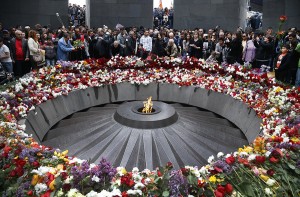Armenians Commemorate Centenary of Genocide
April 24, 2015
Today marks the date that Armenians recognize as the beginning of the Armenian Genocide. One hundred years ago, on April 24, 1915, the Ottoman Empire began rounding up Armenian writers and intellectuals in Istanbul, in what is now Turkey. The Armenians were executed. Over the next few years, some 1.5 million Armenians were killed outright by the Ottomans or by genocidal policies the Ottoman Empire instituted.

In Yerevan, Armenia, on April 24, 2015, people place flowers at a memorial to the Armenians killed by the Ottoman Empire. Armenians mark the day as the beginning of the mass killings that occurred 100 years ago during World War I. Credit: AP Photo
During World War I (1914-1918), Germany, Austria-Hungary, and the Ottoman Empire formed the alliance of the Central Powers. Russia, France, and the United Kingdom were among the Allied Powers fighting against them. During World War I, Armenia was a battleground between the Ottoman and Russian empires. The Ottoman government became concerned with Armenian support for Russia. After the executions of the intellectuals, many other men were rounded up and killed by the Ottomans. In the same year, the Ottoman government began deporting Armenians, many of them women and children, from western Armenia into a desert area in what is now part of Syria. In total, about 1.5 million Armenians were killed or died from lack of water and food.
Genocide is the systematic extermination of an ethnic or racial group. The Turkish government claims that the incidents during World War I did not constitute genocide. Historians generally agree, however, that the Armenian deaths were the result of genocide.
After World War I, the Ottoman Empire was dissolved and the government of Turkey came into being. High-ranking government officials and rulers from the former Ottoman Empire fled to other parts of Europe. At the time, there was no international law that covered genocide. Ottoman rulers were able to travel in Europe after the war with no fear of repercussions. In 1920, a number of Armenians began Operation Nemesis, which set out to assassinate former rulers whom they believed had been responsible for the mass killings of Armenians. A number of former leaders from the Ottoman Empire were killed from 1920 to 1922. One of the assassins, Soghomon Tehlirian, openly killed one of the highest rulers of the former Ottoman Empire, Talaat Pasha, in Berlin. Tehlirian’s trial led to information on the Armenian Genocide being more widely disseminated. He was acquitted by a German jury.
Other World Book article:


